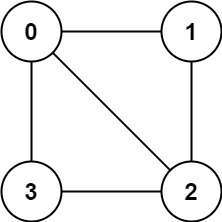Is Graph Bipartite
There is an undirected graph with n nodes, where each node is numbered between 0 and n - 1. You are given a 2D array graph, where graph[u] is an array of nodes that node u is adjacent to. More formally, for each v in graph[u], there is an undirected edge between node u and node v. The graph has the following properties:
- There are no self-edges (
graph[u]does not containu). - There are no parallel edges (
graph[u]does not contain duplicate values). - If
vis ingraph[u], thenuis ingraph[v](the graph is undirected). - The graph may not be connected, meaning there may be two nodes
uandvsuch that there is no path between them.
A graph is bipartite if the nodes can be partitioned into two independent sets A and B such that every edge in the graph connects a node in set A and a node in set B.
Return true if and only if it is bipartite.
Example 1:

Input: graph = [[1,2,3],[0,2],[0,1,3],[0,2]]
Output: false
Explanation: There is no way to partition the nodes into two independent sets such that every edge connects a node in one and a node in the other.
Example 2:

Input: graph = [[1,3],[0,2],[1,3],[0,2]]
Output: true
Explanation: We can partition the nodes into two sets: {0, 2} and {1, 3}.
Constraints:
graph.length == n1 <= n <= 1000 <= graph[u].length < n0 <= graph[u][i] <= n - 1graph[u]does not containu.- All the values of
graph[u]are unique. - If
graph[u]containsv, thengraph[v]containsu.
Solution
A bipartite graph is a graph that can be paritiioned into two sets (A and B) such that every edge in the graph connects a node in A and a node in B.
By traversing through the graph breadth first, we can partition the nodes into two sets, nodes in the even level and the odd level.
We will specifically make sure that two nodes on the same level don't have a connection to guarantee that the graph is bipartite.
Implementation
Let's implement this problem by enforcing statement 3, checking whether there are links between nodes on the same level.
def isBipartite(graph: List[List[int]]) -> bool:
visited = [False for _ in range(len(graph))]
def bfs(root):
queue = deque([root])
curlevel = set([0])
while queue:
length = len(queue)
newlevel = set()
for _ in range(length): # for nodes in each level
node = queue.popleft()
for neighbor in graph[node]:
if neighbor in curlevel: # edge connecting nodes on the same level
return False
if visited[neighbor]:
continue
newlevel.add(neighbor)
queue.append(neighbor)
visited[neighbor] = True
curlevel = newlevel
return True
for i in range(len(graph)):
if not visited[i] and not bfs(i):
return False
return True
Ready to land your dream job?
Unlock your dream job with a 5-minute evaluator for a personalized learning plan!
Start EvaluatorConsider the classic dynamic programming of longest increasing subsequence:
Find the length of the longest subsequence of a given sequence such that all elements of the subsequence are sorted in increasing order.
For example, the length of LIS for [50, 3, 10, 7, 40, 80] is 4 and LIS is
[3, 7, 40, 80].
What is the recurrence relation?
Recommended Readings
Coding Interview Patterns Your Personal Dijkstra's Algorithm to Landing Your Dream Job The goal of AlgoMonster is to help you get a job in the shortest amount of time possible in a data driven way We compiled datasets of tech interview problems and broke them down by patterns This way
Recursion If you prefer videos here's a video that explains recursion in a fun and easy way Recursion is one of the most important concepts in computer science Simply speaking recursion is the process of a function calling itself Using a real life analogy imagine a scenario where you invite your friends to lunch https assets algo monster recursion jpg You first call Ben and ask him
Runtime Overview When learning about algorithms and data structures you'll frequently encounter the term time complexity This concept is fundamental in computer science and offers insights into how long an algorithm takes to complete given a certain input size What is Time Complexity Time complexity represents the amount of time
Want a Structured Path to Master System Design Too? Don’t Miss This!
